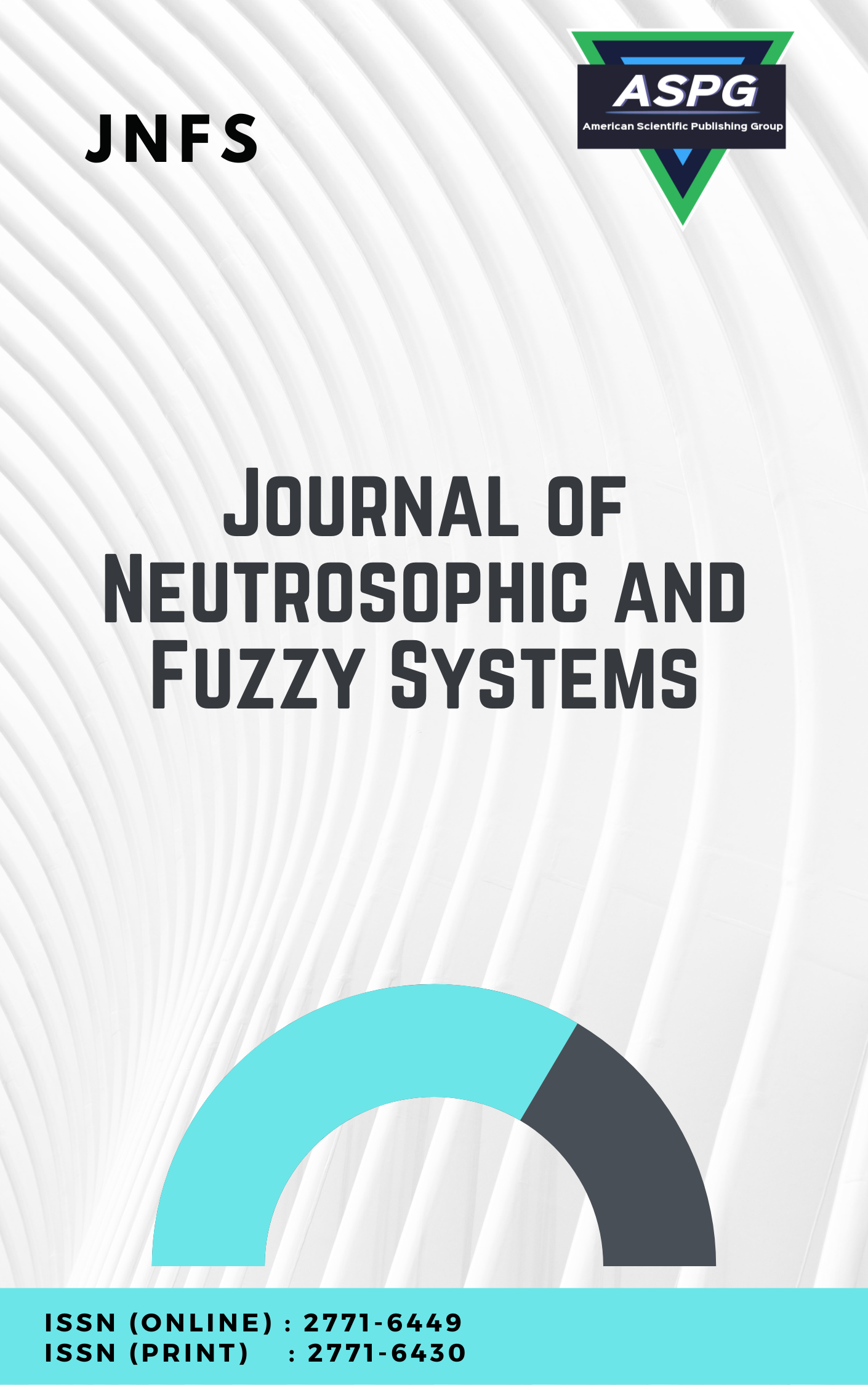

Volume 10 , Issue 1 , PP: 34-51, 2025 | Cite this article as | XML | Html | PDF | Full Length Article
Takaaki Fujita 1 * , Arif Mehmood 2
Doi: https://doi.org/10.54216/JNFS.100104
Numerous frameworks have been developed to address uncertainty in various domains. Among the most prominent are Fuzzy Sets, Rough Sets, Hyperrough Sets, Vague Sets, Intuitionistic Fuzzy Sets, Neutrosophic Sets, Plithogenic Sets, as well as other emerging theories that continue to be actively explored. These concepts for handling uncertainty have also been studied in the context of educational applications. In this paper, we provide formal mathematical definitions for the Fuzzy Education Process and the Neutrosophic Education Process. These educational process frameworks are applicable in a wide range of contexts, including secondary education, corporate training programs, and beyond.
Fuzzy set , Neutrosophic Set , Education Process , Fuzzy Education Process , Neutrosophic Education Process
[1] Lotfi A Zadeh. Fuzzy sets. Information and control, 8(3):338–353, 1965.
[2] Ajoy Kanti Das and Carlos Granados. Ifp-intuitionistic multi fuzzy n-soft set and its induced ifp-hesitant n-soft set in decision-making. Journal of Ambient Intelligence and Humanized Computing, 14:10143 – 10152, 2022.
[3] Krassimir T Atanassov and G Gargov. Intuitionistic fuzzy logics. Springer, 2017.
[4] Mohaddeseh Rahimipour Sheikhani Nejad, Lotfallah Pourfaraj, et al. Single-valued intuitionistic neutrosophic sets. Caspian Journal of Mathematical Sciences, 2025.
[5] M Kanchana and K Kavitha. Sensitivity analysis and application of single-valued neutrosophic transportaion problem. Journal of King Saud University-Science, 36(11):103567, 2024.
[6] V Divya, J Jesintha Rosline, and A Anthoni Amali. Regularity of fermatean quadripartitioned neutrosophic fuzzy graph. In International Conference on Intelligent and Fuzzy Systems, pages 39–47. Springer, 2025.
[7] Piyush Sharma and Akanksha Singh. Solving a quadri-partitioned neutrosophic transportation problem using score function for madm. Sustainable Computing and Intelligent Systems: Proceedings of SCIS 2024, Volume 1, 1295:125, 2025.
[8] Rama Mallick and Surapati Pramanik. Pentapartitioned neutrosophic set and its properties, volume 36. Infinite Study, 2020.
[9] Jerome S Bruner. The process of education. Harvard university press, 2009.
[10] Richard S Peters. What is an educational process? In The Concept of Education (International Library of the Philosophy of Education Volume 17), pages 1–16. Routledge, 2010.
[11] Robin Alexander. Versions of primary education. Routledge, 2013.
[12] Linda Clarke and Christopher Winch. Vocational education. Routledge, 2012.
[13] Lesley Farrell. Workplace education and corporate control in global networks of interaction. Journal of Education and Work, 17(4):479–493, 2004.
[14] Gabriela Gabrhelov´a, Marta Matulˇc´ıkov´a, Eva Dolinsk´a, Silvia Barnov´a, and Daniela Breven´ıkov´a. Professional corporate employee education from the point of view of the types of education and the applied forms of education. International Journal of Engineering Pedagogy, 13(2), 2023.
[15] Bryan G Cook and Barbara R Schirmer. What is special about special education? overview and analysis. The Journal of Special Education, 37(3):200–205, 2003.
[16] R Ilahi, I Widiaty, and A Gafar Abdullah. Fuzzy system application in education. In IOP Conference Series: Materials Science and Engineering, volume 434, page 012308. IOP Publishing, 2018.
[17] Ibrahim A Hameed and Claus G Sorensen. Fuzzy systems in education: a more reliable system for student evaluation. ISBN, 2010.
[18] Chunyan Xing. Management model of higher education based on innovative using fuzzy sets. Journal of Fuzzy Extension and Applications, 5(3):469–493, 2024.
[19] Takaaki Fujita. Enhanced concepts and methods for representing real-life logical correctness in fuzzy frameworks. EngrXiv, 2025.
[20] Jayanta Ghosh and Tapas Kumar Samanta. Hyperfuzzy sets and hyperfuzzy group. Int. J. Adv. Sci. Technol, 41:27–37, 2012.
[21] Young Bae Jun, Kul Hur, and Kyoung Ja Lee. Hyperfuzzy subalgebras of bck/bci-algebras. Annals of Fuzzy Mathematics and Informatics, 2017.
[22] Vicenc¸ Torra and Yasuo Narukawa. On hesitant fuzzy sets and decision. In 2009 IEEE international conference on fuzzy systems, pages 1378–1382. IEEE, 2009.
[23] Reinhard Diestel. Graph theory. Springer (print edition); Reinhard Diestel (eBooks), 2024.
[24] Alain Bretto. Hypergraph theory. An introduction. Mathematical Engineering. Cham: Springer, 1, 2013.
[25] Yifan Feng, Haoxuan You, Zizhao Zhang, Rongrong Ji, and Yue Gao. Hypergraph neural networks. In Proceedings of the AAAI conference on artificial intelligence, volume 33, pages 3558–3565, 2019.
[26] Eduardo Luciano Hernandez Ramos, Luis Ramiro Ayala Ayala, and Kevin Alexander Samaniego Macas. Study of factors that influence a victim’s refusal to testify for sexual reasons due to external influence using plithogenic n-superhypergraphs. Operational Research Journal, 46(2):328–337, 2025.
[27] Mohammad Hamidi and Mohadeseh Taghinezhad. Application of Superhypergraphs-Based Domination Number in Real World. Infinite Study, 2023.
[28] Muhammad Rayees Ahmad, Usman Afzal, Nadir Omer, Ali Delham Algarni, Sara A Ghorashi, and Huda Eltayeb. A computational diagnostic model for infectious diseases via similarity measures on n-framed plithogenic hypersoft sets. Alexandria Engineering Journal, 127:1209–1219, 2025.
[29] Fazeelat Sultana, Muhammad Gulistan, Mumtaz Ali, Naveed Yaqoob, Muhammad Khan, Tabasam Rashid, and Tauseef Ahmed. A study of plithogenic graphs: applications in spreading coronavirus disease (covid-19) globally. Journal of ambient intelligence and humanized computing, 14(10):13139–13159, 2023